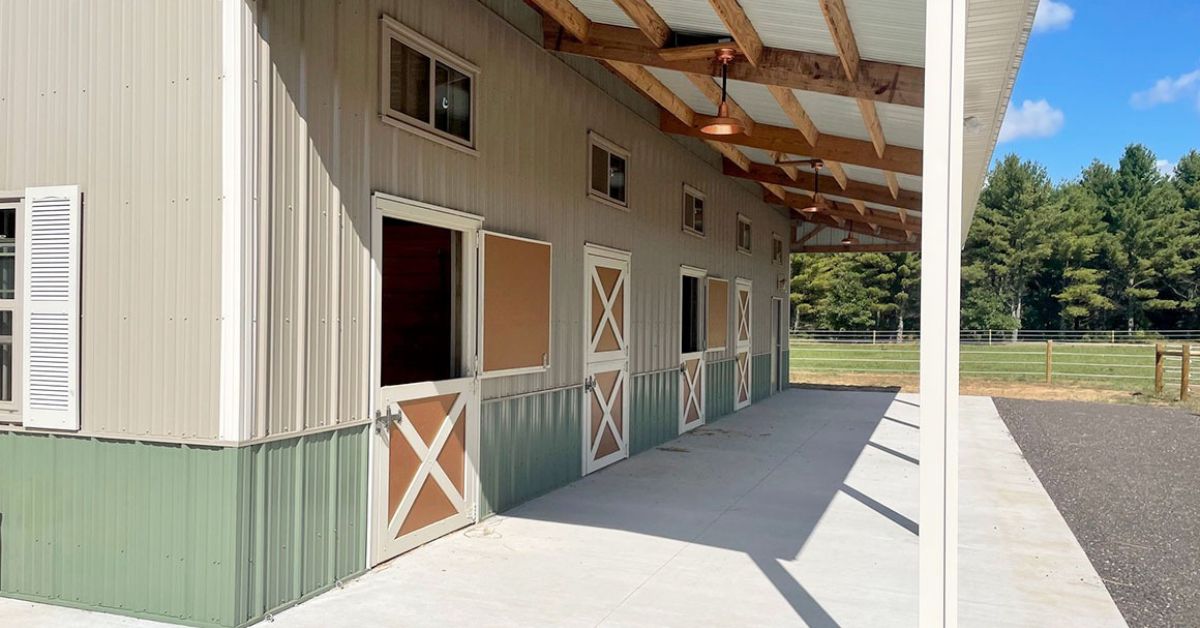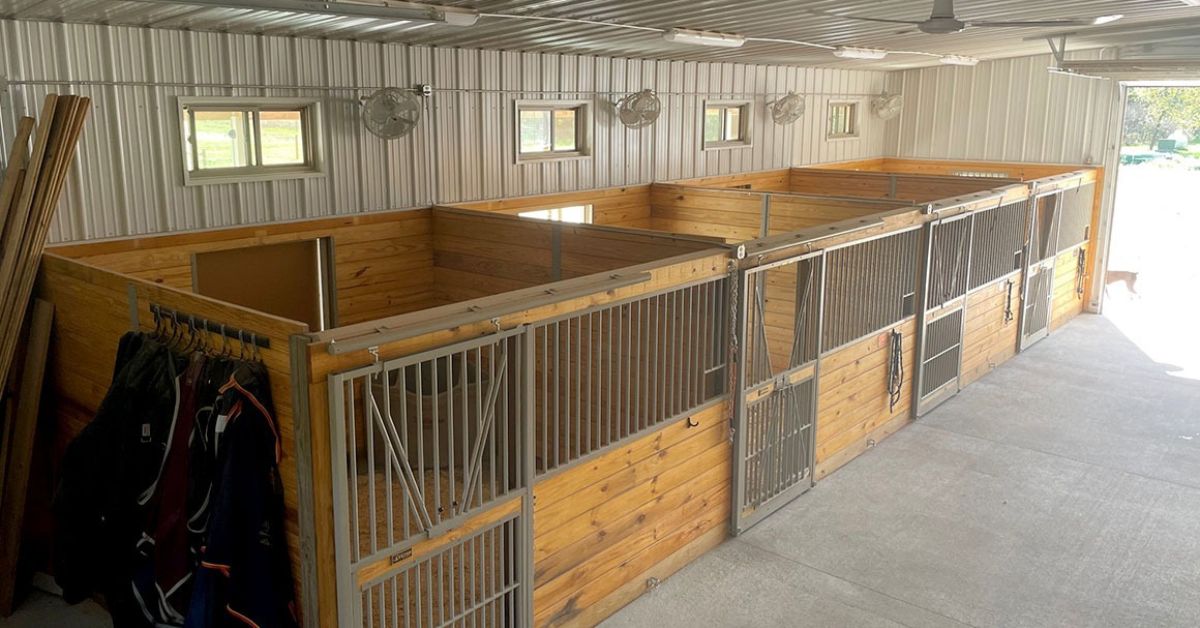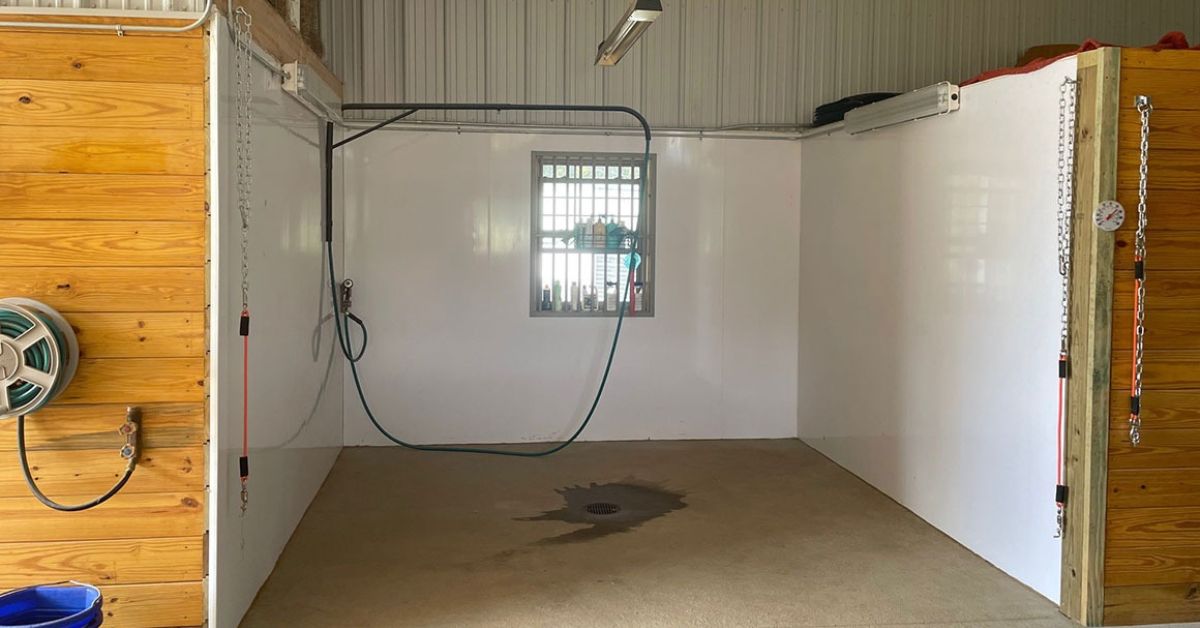Building a Horse Barn That Prioritizes Safety and Function
.jpg)
Building a barn is one of the most significant investments horse owners can make. Beyond providing shelter, a well-designed barn serves as the foundation for daily horse care routines, equipment storage, and overall farm operations. A thoughtfully planned barn can impact everything from your horses' health to property management.
Horses are powerful animals with natural flight instincts, making them prone to injury in poorly designed spaces. That's why building a horse barn that prioritizes safety and function is so important. Here's how to achieve a barn that excels in both areas, serving you and your horses for decades to come.
Why invest in a horse barn?
Horse barns provide essential benefits that extend far beyond basic shelter:
- Weather protection from rain, snow, wind, and extreme temperatures
- Secure storage for feed, tack, and expensive equipment
- Health management space for veterinary care and quarantine when needed
- Organized feeding areas that support consistent nutrition schedules
- Equipment accessibility with designated spaces for tools and machinery
- Property value enhancement through professional farm infrastructure
Let's explore ten crucial tips that will help you create a barn that prioritizes both safety and function.
Tip 1: Proper Site Selection and Planning
Location determines your barn's long-term success. Choose elevated ground that naturally drains water away from the structure. Avoid low-lying areas where water pools, as moisture creates unsafe footing and promotes bacterial growth.
Consider prevailing wind patterns when positioning your barn. Placing the structure to catch summer breezes improves natural ventilation, while positioning it to block harsh winter winds protects horses from cold stress. South-facing orientations maximize natural light and warmth during colder months.
Tip 2: Optimized Barn Layout and Traffic Flow
Design your barn layout to minimize stress for both horses and handlers. Wide aisles, at least 12 feet across, allow horses to move comfortably without feeling cramped. This width also accommodates wheelbarrows, feed carts, and emergency equipment.
Create logical traffic patterns that separate different activities. Position feed storage away from high-traffic grooming areas. Place wash stalls near water sources but away from feed storage to prevent contamination. Consider how horses will enter and exit the barn, ensuring they won't have to navigate tight corners or narrow passages.
Tip 3: High-Quality, Safe Building Materials
Material selection directly impacts both safety and longevity. Choose lumber that's free from sharp edges, splinters, and protruding hardware. Avoid materials treated with chemicals that could harm horses if chewed or licked.
For interior surfaces, select materials that resist moisture and are easy to clean. Sealed concrete, rubber mats, and smooth wood surfaces work well. Avoid rough textures where bacteria can accumulate or horses can injure themselves.
Tip 4: Ventilation and Air Quality Management
Poor air quality causes respiratory problems that can permanently damage horses' performance and health. Design your ventilation system to provide continuous air exchange without creating drafts at the horse's level.
Install ridge vents along the roof peak to allow hot air to escape naturally. Complement these with soffit vents under the eaves to draw fresh air into the barn. This creates natural air circulation without requiring electricity.

Tip 5: Natural Light and Electrical Safety
Horses perform better in well-lit environments. Natural light reduces stress, supports healthy circadian rhythms, and makes the barn safer for daily activities. Install windows positioned above horse reach, typically 8 feet or higher, to prevent injury while maximizing light penetration.
Additionally, plan lighting for both general illumination and task-specific needs. Overhead fixtures should provide even coverage throughout aisles and work areas.
Tip 6: Stall Design for Horse Comfort and Safety
Stall dimensions must accommodate horses comfortably while promoting natural movement. Standard 12x12-foot stalls work for most horses, but larger animals may need 12x14 or 14x14-foot spaces. The height should reach at least 8 feet to prevent horses from hitting their heads.
Eliminate sharp corners and protruding hardware inside stalls. Round corners where possible, and countersink all screws and bolts. Door latches should be horse-proof but easy for humans to operate quickly in emergencies.
Tip 7: Flooring and Drainage Solutions
Barn flooring must balance safety, comfort, and maintenance requirements. Concrete provides durability and easy cleaning, but can be hard on horses' legs and slippery when wet. Add rubber mats or textured surfaces to improve traction and comfort.
Install proper drainage throughout the barn to handle wash water, rain, and cleaning activities. Floor drains should connect to appropriate waste management systems that comply with local environmental regulations.
Tip 8: Fire Safety Measures
Fire poses the greatest safety threat to horse barns. Install smoke detectors connected to monitoring systems that alert you even when you're away from the property. Consider heat detectors in areas where dust might trigger false alarms.
Store hay and bedding in separate buildings when possible. If you must store these materials in the barn, use fire-resistant construction for storage areas and maintain clearances from electrical equipment.
Tip 9: Storage Solutions for Feed and Equipment
Organized storage improves efficiency and safety while protecting expensive equipment and feed from weather and pests. Design dedicated spaces for different types of storage rather than trying to make multipurpose areas work.
Metal containers with tight-fitting lids work well for grain, while hay storage needs adequate ventilation to prevent mold. Equipment storage should accommodate everything from daily grooming supplies to seasonal items such as blankets and show equipment.

Tip 10: Regular Maintenance and Inspections
Even the best-built barn requires ongoing maintenance to remain safe and functional. Develop inspection routines that identify problems before they become dangerous or expensive to repair.
Check electrical systems annually for damaged wiring, loose connections, or outdated components. Inspect structural elements seasonally, looking for loose boards, protruding nails, or damaged hardware.
Why choose a prefabricated structure for your horse barn?
Prefabricated horse barns offer several advantages over traditional stick-built construction. These structures arrive with engineered components that meet specific load requirements and building codes. Quality manufacturers design their systems with horse safety in mind, eliminating many common construction mistakes.
Prefab barns typically cost less than custom construction while offering faster installation times. Many companies provide complete packages including electrical, plumbing, and specialized equine features. This approach can reduce overall project complexity while ensuring professional results.
Creating Your Perfect Equine Facility
Building a horse barn that prioritizes safety and function requires careful planning, quality materials, and attention to detail. Each decision you make will impact your horses' safety and well-being. In most situations, investing in quality construction and safety features costs less than dealing with injuries or structural problems later.
Your horses deserve a facility that protects their health and supports their performance. Prefabricated horse pole barns make the perfect solution for those who want a quick and affordable solution. With Lester Buildings, you'll have no trouble crafting the comfortable environment your horses need to thrive!
